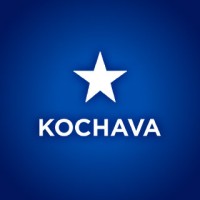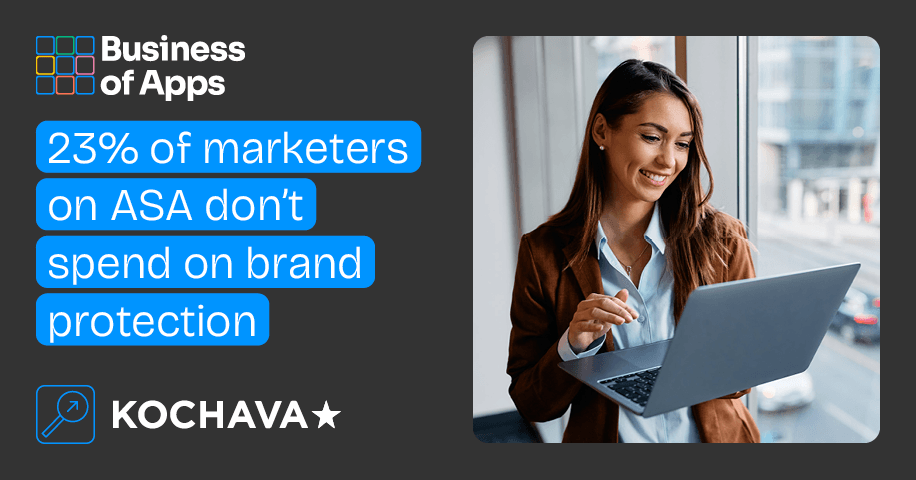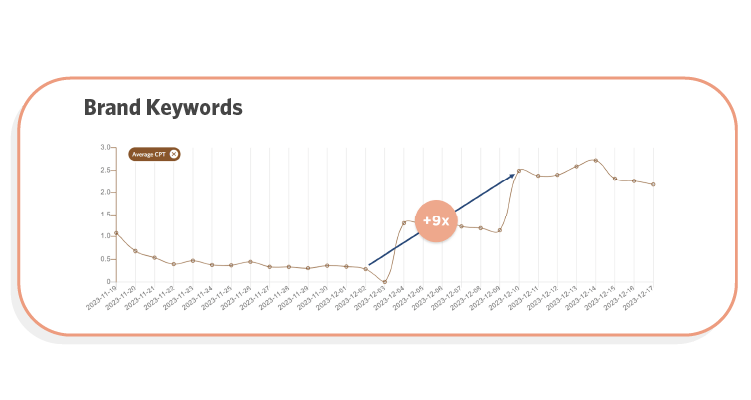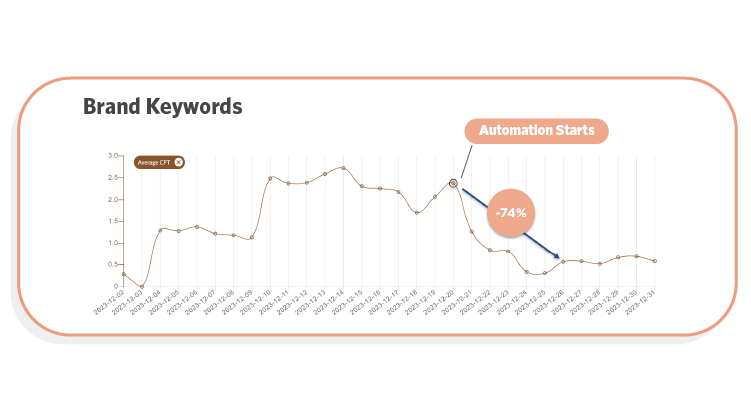During a recent webinar, our team polled a large audience of marketers, inquiring what per cent of their paid search budget on Apple Search Ads (ASA) is dedicated to brand protection. The results were as follows:
| % of poll respondents | Share of ASA budget dedicated to brand protection |
| 23% | Not spending on brand protection |
| 18% | <10% |
| 27% | ~25% |
| 14% | ~50% |
| 9% | ~75% |
| 9% | ~90% |
Where do you fall along the percentage of brand spend spectrum, and why?
Whenever I ask a marketer how they’re approaching brand protection on ASA, I typically find they fall into one of three strategy categories:
Source: Kochava
Category 1 – Win everything
Category 1 are those brands that want to win every impression served on their brand term. They often have a large budget, set a high max bid, and aim to dominate impression share at all costs. Essentially, they never want to see a competitor show up under their term in search results.
Category 2 – Exhaust budget daily
In category 2, I encounter brands with a restricted brand protection budget that quickly runs out by midday. While they’re able to protect their brand terms early, they’re completely defenseless for most of the afternoon and evening, which are sometimes the peak hours when they have the most to gain.
Category 3 – Brand spend forbidden
In category 3, I find the ASA skeptics that forbid any meaningful brand spend (if they have any at all) as non-incremental and a waste of ad dollars. In their mind, anyone who searches for their brand terms will ignore conquest ads and proceed to select the brand’s app regardless.
Which of these strategies best describes the approach your organization takes for brand protection on ASA? There’s no right or wrong answer, but depending on where you fall, there’s an opportunity to be much more effective and efficient than what you’re likely doing at present. Let’s go through each of these categories and unpack the best approach to get the biggest bang for your buck (or lack thereof).
Category 1 alternative: Win (nearly) everything (smarter)
If you want to win everything and have budget to burn, chances are you’ve set a high max bid (maybe even all the way up at $999). While this certainly will help you accomplish your goal, your cost per tap (CPT) is going to jump up every time a competitor raises their max bid in an attempt to get impressions on your brand terms.
If that competitor doesn’t win any impressions, they may increase their bid again and again. The pressure of that demand hammers your budget—not theirs. This often becomes unsustainable.
🎶 64% More Downloads With Music: New Data!
64% of users want premium soundtracks. Get exclusive access to the Feed.fm Influence of Music report and see how music drives engagement.
Get the ReportFor example, one brand we worked with had a high max bid designed to protect their brand terms. During the holiday season, their CPT suddenly jumped 9x when a competitor entered the auction with a strong bid. After failing at first to win any impressions, the competitor kept raising their bid. The rapid 9x increase caused the defending brand’s cost per goal (CPG) on a purchase event to increase 10x. Winning everything was becoming too costly.
Source: Kochava
We introduced the brand’s team to a strategy that would allow them to win “nearly” everything while keeping runaway costs in check. Rather than setting their max bid extremely high, we deployed automation to push the bid down until it was just under that of the prodding competitor. This let the competitor gain impressions for a short period of time, quickly exhausting their budget.
Once the competitor’s budget was spent, they were gone from the auction and the brand was right back to winning bids without the competitor pressuring their budget northward. Their average CPT dropped 74%, and get this—there was a near 0% impact on their overall impression share.
Source: Kochava
It should be noted that dynamically managing your bidding strategies in such a way is close to impossible without automation. The Automation Studio within Search Ads Maven by Kochava, an ASA campaign management platform, enables the creation of bespoke automation rules for scenarios such as these.
It can be leveraged to create an always-on bidding manager that monitors bidding dynamics hourly and adjusts your max bid based on target KPIs (e.g., impression share, CPT, CPG). Another brand for which this same strategy was adopted lowered their average brand CPT 85%, while maintaining nearly equal impression share on new install targets.
Category 2 alternative: Make your budget last all day
Suppose you’re in category 2. You may have a budget, but it never seems to be enough to get you through the whole day. By afternoon, evening, and into the night, it’s open season on your brand keywords. If you’re a food and drink app with a dinner business, that downright hurts. We see this a lot, and those who have spoken with an Apple rep say they’re often advised to just increase their daily budget. This leaves them with two options, neither of which they like.
Oftentimes, the culprit is a bid that’s simply too high. Similar to category 1 previously discussed, bids from competitors are increasing your CPT dramatically and squeezing your daily budget dry way too quickly. Lowering your bid and giving up a small amount of impression share exhausts smaller competitor budgets instead, removing them from the auction.
This in turn reduces your average CPT and extends your budget to the end of the day. Assuming you don’t want to monitor your bids all day, manipulating them hourly to account for actions by the competition, automation is your best friend in enacting a daily budget pacing strategy.
The following graphs show the before and after impact when a brand applied a budget pacing automation strategy through our Search Ads Maven platform. Previously, their daily budget was almost always exhausted by 2 pm. After activating automation, the same daily budget consistently extended until 10 pm—with a dramatic improvement in performance.
Before automation
Source: Kochava
After automation
Source: Kochava
Category 3 alternative: Leverage your brand
So you don’t want to spend on brand? I totally get it. Many argue that it’s not the most incremental thing to do. However, just imagine for a moment how much more incremental your brand terms become for your competitors when you’re completely absent from the auction. If you’re bidding nothing, they’re getting your brand terms at a much lower price.
Simply by participating in the bidding, even if at a low bid amount where you win very little, you can make it less incremental for your competitors to conquest you. With a minuscule daily budget, you can use automation to win a small share of impressions and actively participate in the bidding wars over your brand terms. There’s no reason to lay down without a fight.
Efficient and effective brand protection
Whatever your approach is to paid search, especially on Apple Search Ads, there are unique strategies and tools you can leverage to carve out greater efficiencies.
If you’re not happy with the status quo of your brand protection playbook on ASA, connect with my team at Search Ads Maven. We love exploring challenges and helping find solutions.

















